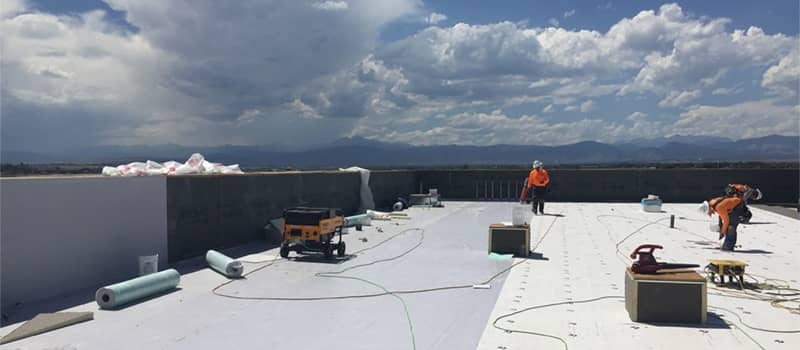We don’t really think about roofs until they stop working. A leak caused by damage, pooling or other problems will make an urgent priority out of something you never think about.
Whether you have a massive commercial structure or an average home, roof repairs or replacements can be costly. With lifespans that can easily span decades, it can be hard to determine if a roof needs to be replaced or if professional repairs will extend its life.
Following these simple guidelines can help you determine the best roofing solution for your needs.
Be Proactive
If your roof is near the end of its warranty period (usually 15-20 years), it is likely a good time to evaluate it even if it’s not leaking. This will allow you to tackle problems in favorable weather and avoid unpleasant surprises.
On membrane roofs, check for damage from things like trees and wear, problems with seams and welds, pooling/ponding water and of course leaks. Other visual cues that suggest a replacement is imminent include ridging/splitting on built-up roofs or significant building movement that has affected the integrity of the roof.
You may want to hire an expert to handle this task. They know what to look for and have a good idea of how the roof should look. They also can go beyond a simple visual inspection to uncover deeper problems—sometimes a roof looks OK on top but is rotting beneath the surface. If something is amiss, they will know how best to address it.
A final benefit of getting a good read on your roof is budget. If you know your roof has a few years left, you can start planning and budgeting for a replacement rather than suffering the strain of doing the job at an unexpected time.
Not All Leaks Are Equal
A small leak may or may not mean a small problem. Again, look for physical damage, ponding or issues with seams and welds near the leak. If there is an obvious problem, a repair may do the trick. Be careful, however: Multiple or repeated leaks are likely a sign of serious underlying trouble. Repeatedly addressing those leaks will become a costly distraction, and replacement is almost certainly the better option.
Another consideration is what the roof is protecting. A large leak in a warehouse may go unnoticed while a small leak in a hospital could cause significant property and operational damage. What’s under the roof should help guide your decision making.
The Costs of Waiting
Ignoring your roof can have devastating consequences. A slow leak could be rotting rafters and support beams that affect the integrity of the building itself or causing other damage that you won’t know about until it’s a crisis. Don’t let a small leak become a major expense.
Use Your Warranty
If your roof is under warranty and presenting a problem, take advantage of the manufacturer’s backing. Determine what is and is not covered so you fully understand your rights. Unfortunately, some roofing materials manufacturers don’t cover some common causes of problems like ponding, or they may no longer be in business, so a replacement may still be your best solution.
Replacement Considerations
If it’s time to replace your roof, a single-ply membrane solution is often the fastest, most durable, most effective—and ultimately most cost-effective—solution. These can be applied directly over existing roofs, eliminating expensive removal and construction costs. There are many choices when it comes to membrane roofs. When evaluating your options, consider:
- Basic needs.
- What is it protecting? A cheap roof can be very expensive if problems will disrupt operations or damage property at a busy factory, hospital or other key facility.
- Do you want multiple color and/or design options? A fully adhered membrane roof can be very aesthetically pleasing.
- Uses.
- Will the roof be walked on or face other high-wear demands?
- Does the roof include a solar array? Moving the array for repair or replacement of a cut-rate roof can be a large expense.
- Durability.
- Make sure the roof is made of quality material and can pass a puncture test—a good provider will provide a demonstration for you.
- Geographic location.
- Cooler climates may need more insulation while wetter climates may need more durability and waterproofing
- Sunny climates may benefit from UV resistance or a variety of reflective colors for energy consumption benefits.
- Warranty.
- Be sure to compare apples to apples. Go beyond the number of years a warranty covers and look at what it covers. Ask to see examples of similar applications in similar environments to see how your new roof might perform and last.
- Look for providers with a long track record of success. Not only will they be around to back your warranty, but their longevity is a good testament to their quality.
No matter how old it is, don’t forget about your roof. Putting off evaluations or repairs can lead to problems down the line. If it’s time for a replacement and you do want to forget about your roof for a long time, a single-ply membrane offers many advantages. It goes on fast, lasts for decades and stands up to weather and wear.
What is your experience with roofing evaluations or repairs? Tell us about them in the comments!
-1.png?width=500&height=271&name=FiberTite_Only%20(500px%20wide)-1.png)



-1.png)